You might be familiar with the term Sexually Transmitted Disease (STD), but there has been a shift to the term Sexually Transmitted Infection (STI) in recent years, because the term “disease” can indicate a specific medical issue, whereas some viruses do not have any signs or symptoms, or people can have mild signs that can be overlooked. Some STIs can be the result of bacteria that can lead to an infection, but may not result in disease, which is why we’re seeing more frequent use of the term STI compared to STD, but both terms refer to the same topic, so you should feel comfortable using the term that feels right for you.
According to data from the World Health Organisation (WHO), more than 30 different bacteria, viruses and parasites are known to be transmitted through sexual intercourse, although 8 are more common. Some of the bacteria, viruses and parasites are curable, such as Syphilis, Gonorrhoea and Chlamydia, whereas some are incurable, such as Hepatitis B, Herpes Simplex Virus, Human Immunodeficiency Virus (HIV) and Human Papilloma Virus (HPV). It is believed that more than 1 million Sexually Transmitted Infections (STIs) are acquired around the world each day, with many of them asymptomatic.
Out of these infections, an estimated 374 million new infections involved Chlamydia (129 million), Gonorrhoea (82 million), Syphilis (7.1 million) and Trichomoniasis (156 million). More than 500 million people aged 15 to 49 years of age are estimated to have a genital infection with Herpes Simplex Virus (HSV) type 1. After hearing these figures, you might start thinking about putting a rubber on your dick the next time you fuck or get fucked, but condoms do not prevent some of these STIs, such as Syphilis or Herpes Simplex Virus, plus condoms also eliminate the exciting experience we enjoy when we bareback. Health professionals advise that condoms do provide effective methods of protection against many STIs, including HIV, so this information is being included here to provide balance to this article.
Some STIs can be prevented through vaccines, such as Hepatitis B and Human Papilloma Virus (HPV), while others can be effectively treated and cured through single-dose regimens of antibiotics, including Chlamydia, Gonorrhoea and Syphilis. When it comes to Herpes Simplex Virus and Human Immunodeficiency Virus, antivirals can help manage the disease, but they cannot cure it. Antiviral medications can help treat Hepatitis B and slow damage caused to the liver. There is also a concern about Gonorrhoea becoming resistant to antibiotics, which may eventually become untreatable.
It’s important to understand that a person can have an STI without having any symptoms and sometimes symptoms can vary and include discharge, burning sensation, sores and abdominal pain. Some STIs can increase the chances of contracting other STIs, such as Herpes Simplex Virus, Gonorrhoea and Syphilis improving the chances of acquiring HIV due to the symptoms of sores damaging the body’s natural defence mechanism, which is the skin barrier, so these STIs can make it easier for HIV to be transmitted from one person to another.
Last month, the Centers for Disease Control and Prevention (CDC) released their draft guidelines on the use of Doxy-PEP for preventing some STIs, with the 45 day input period about to come to a close. Doxy-PEP uses an old antibiotic called Doxycycline to reduce the risk of developing Syphilis, Gonorrhoea and Chlamydia, which are very common STIs. The drug works similar to PEP for HIV prevention, which must be taken within 72 hours of exposure to HIV for it to be effective and Doxy-PEP must also be taken within 3 days of exposure for it to stop the development of certain STIs. Normally taken as a table once or twice a day, the drug can start to improve a patient’s symptoms within 2 days. There is a concern that the use or Doxy-PEP could worsen antibiotic resistance, especially Gonorrhoea.
To help you understand the most common Sexually Transmitted Infections (STIs), the information below includes some useful information about what to look out for and whether there are any treatment options available. Please be aware that the information provided in this article (and everything published at this website) is general in nature and must not be used for self-diagnosis. If you believe that you may have a Sexually Transmitted Infection, please seek professional medical advice as soon as possible so a medical professional can make a proper diagnosis. A special thank you to STI Atlas for making the pictures available on this page to help you identify some of the symptoms.
Chancroid (Bacterial)
Cases of Chancroid are considered to be rare in most countries, but is still common in parts of Africa, south west Asia and the Caribbean. Chancroid is caused by a bacteria called Haemophilus ducreyi and is passed on through anal, oral or vaginal sex with an infected person. After infection, one or more sores develop on the genitals or around the anus, which can increase the chances of HIV transmission. The sore begins with a red lump at the site of the infection, then fills with pus and eventually ruptures to create an open sore. Painful lymph glands can also occur in the groin, usually on one side of the body, although sometimes both sides can be affected.
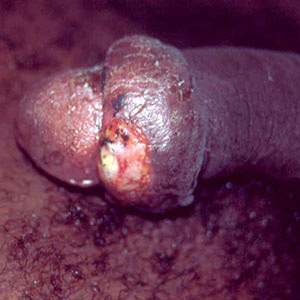
Affected Areas: Penis, Scrotum, Anus, Groin
Symptoms:
- Usually appear between 4 to 10 days from exposure
- Sores develop on the genitals or around the anus
- Starts with a red lump, then becomes an open sore once the lump ruptures
- Painful lymph glands in the groin (mainly on one side)
- Some people may not show any symptoms
Transmission Sources:
- Unprotected anal, oral or vaginal sex
- A non-infected person’s genitals touching an infected person’s genitals
Treatable: Yes (antibiotics). Painkillers can also be taken if the sores are painful.
Chlamydia (Bacterial)
Chlamydia is caused by a bacteria called chlamydia trachomatis that results in an infection in the genital area. It can get into the urethra and it can also infect the rectum and sometimes it can spread from the genital area to other parts of the body including the eyes and throat. Chlamydia is spread by sexual contact through anal, oral or vaginal sex and is one of the most common Sexually Transmitted Infections. Most people do not notice any symptoms, but the symptoms will usually appear 1 to 3 weeks after having unprotected sex with someone who has the infection and can also develop months later. Chlamydia can cause serious health problems later in life, but can be treated successfully with the use of antibiotics.
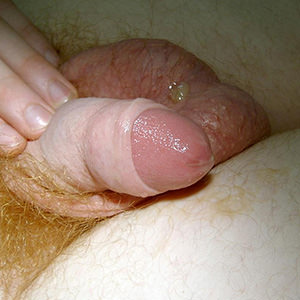
Affected Areas: Eyes, Penis, Rectum, Testicles, Throat, Urethra
Symptoms:
- Usually appear between 1 and 3 weeks after exposure, but may not emerge until months later
- Pain or burning sensation when urinating
- White, cloudy or watery discharge from the penis
- Pain and/or swelling in the testicles
- Burning or itching in the urethra
Transmission Sources:
- Unprotected anal, oral or vaginal sex
- A non-infected person’s genitals touching an infected person’s genitals
- Sharing unwashed or uncovered sex toys with someone who has the infection
- Infected semen or vaginal fluid getting into a non-infected person’s eye
Treatable: Yes (antibiotics)
Genital Warts (HPV) (Viral)
Genital warts are fleshy growths or bumps seen most often in moist areas in and around the genitals and anus including the inside of the opening of the urethra and may also be inside the anal canal. They are caused by a group of viruses called Human Papilloma Virus (HPV). Genital warts are highly contagious, very common and can recur. Genital warts can appear as white or flesh-coloured, smooth, small bumps, or larger, fleshy cauliflower-like lumps. Not everyone infected with HPV will develop genital warts. Some will be infected with a strain that does not produce warts, or they will not appear, even though the virus is present in the skin or mucous membranes around the genital area. You can apply drugs directly onto warts which will cause them to disappear, but they may reappear in the future. A vaccine is available to prevent certain types of HPV that cause most cases of genital warts.
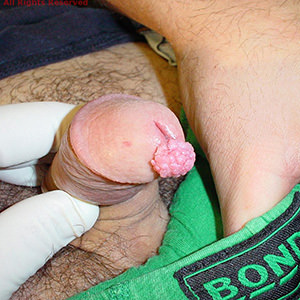
Affected Areas: Anus, Mouth, Penis, Scrotum, Thighs, Throat, Urethra
Symptoms:
- May appear 1 to 3 months after initial infection
- Flesh-coloured or grey painless growths or lumps around your penis, anus or upper thighs
- Itching or bleeding from the genitals or anus
- A change to the normal flow of piss (such as sideways) that doesn’t go away
Transmission Sources:
- Unprotected anal, oral or vaginal sex
- A non-infected person’s genitals touching an infected person’s genitals
- Sharing unwashed or uncovered sex toys with someone who has the infection
Treatable: Yes (with creams, freezing or heating)
Gonorrhoea (Bacterial)
Gonorrhoea is caused by a bacteria called Neisseria gonorrhoeae or gonococcus and used to be known as “the clap”. Gonorrhoea can cause a white, yellow or green discharge from the penis, along with pain when passing urine. Most of the symptoms of infection will start within 1 to 14 days of infection and include a vague ache of the joints and muscles. Although these symptoms can disappear after a further 10 or so days, you are still considered to be infectious. If left untreated, Gonorrhoea can affect the prostate gland, spread to the testicles, result in fever and scrotal pain, can affect the joints and tendons and in rare cases result in skin irritation and inflammation around the brain and spinal cord or the heart. Gonorrhoea can be cured with antibiotics, although some drug-resistant strains are known to exist.
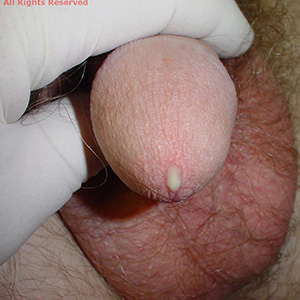
Affected Areas: Anus, Penis, Rectum, Testicles, Throat, Urethra
Symptoms:
- May appear in 1 to 14 days after exposure
- White, yellow or green discharge from this penis
- Pain or burning sensation when urinating
- Inflammation or swelling of the foreskin
- Pain in the testicles (this is rare)
- Possibly no symptoms until it spreads further
Transmission Sources:
- Unprotected anal, oral or vaginal sex
- Sharing unwashed or uncovered sex toys with someone who has the infection
- Through the throat or eyes (less common)
Treatable: Yes (antibiotics). Note: Some drug resistant strains are known to exist.
Hepatitis A (HAV) (Viral)
Hepatitis A is also known as Hep A or HAV and is part of a group of hepatitis viruses that attack the liver. The virus is commonly found in human faeces and is commonly passed on by eating or drinking and can sometimes be passed on through unprotected anal sex and sharing needles. Hepatitis A is not usually serious and clears up on its own after 10 to 14 days.
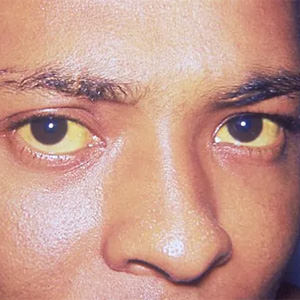
Affected Area: Liver
Symptoms:
- May appear in 2 to 7 weeks
- Sometimes flu-like symptoms, including tiredness, fever, aches and pains
- Nausea, vomiting, diarrhoea, loss of appetite, weight loss
- Jaundice – yellowish skin and whites of eyes, dark urine and pale faeces
- Itchy skin
Transmission Sources:
- Unprotected anal sex
- Sharing contaminated needles and injecting equipment
- Eating food prepared by someone with the virus who has not washed their hands properly
- Drinking dirty water, including ice cubes
- Eating raw or undercooked shellfish from dirty water
- Being in close contact with someone who has Hepatitis A
Treatable: Yes (with vaccination)
Hepatitis B (HBV) (Viral)
Hepatitis B is also known as Hep B or HBV and is one of the more deadly Sexually Transmitted Infections, although there is a protective vaccine to prevent it. It can cause as little as a flu-like illness or as much as total destruction of the liver. Typically, it will cause different degrees of jaundice (yellowing of the skin and the whites of the eyes). There is no way of knowing if the person you are having sex with has the infection. Some people can ‘carry’ the virus and not know they have it. This is a serious liver disease, which can make you very ill. Hepatitis B can take months to recover from and in some cases can be fatal.

Affected Area: Liver
Symptoms:
- May appear in 6 to 90 days
- Often no symptoms – but can be detected by a blood test
- Sometimes flu-like symptoms, including tiredness, fever, aches and pains
- Nausea, vomiting, diarrhoea, loss of appetite, weight loss
- Jaundice – yellowish skin and whites of eyes, dark urine and pale faeces
Transmission Sources:
- Unprotected anal, oral or vaginal sex
- Sharing contaminated needles and injecting equipment
- Using unsterilised tattoo, body-piercing or medical/dental equipment
- Sharing towels, razor blades or toothbrushes with infected blood on them (this is rare)
Treatable: Yes (with vaccination)
Hepatitis C (HCV) (Viral)
Hepatitis C is also known as Hep C or HCV and is part of a group of hepatitis viruses that attack the liver. The virus is commonly found in infected blood, but can sometimes be found in semen. The virus is usually passed on through the use of contaminated needles or syringes, or other items that have infected blood on them and it can also be passed on through unprotected sex, particularly when blood is present. Without treatment, the virus can become chronic and cause liver disease and liver cancer and result in scarring of the liver, called cirrhosis.

Affected Area: Liver
Symptoms:
- May appear in 6 months
- Often no symptoms – but can be detected by a blood test
- Sometimes flu-like symptoms, including tiredness, fever, aches and pains
- Loss of appetite
- Jaundice – yellowish skin and whites of eyes, dark urine and pale faeces
Transmission Sources:
- Unprotected anal sex (involving blood)
- Sharing contaminated needles and injecting equipment
- Using unsterilised tattoo, body-piercing or medical/dental equipment
- The transfusion of unscreened blood and blood products
- Sharing unwashed or uncovered sex toys with someone who has the infection
- Sharing towels, razor blades or toothbrushes with infected blood on them (this is rare)
Treatable: Yes (direct-acting antivirals)
Herpes Simplex Virus (HSV) (Viral)
Herpes Simplex Virus (HSV) is often referred to as Genital Herpes and is a viral infection of the skin which can infect the corners of the mouth, the outer parts of the genital areas and even the anus. There are two types of Herpes Simplex Virus (HSV); HSV-1 and HSV-2. Both cause crusted blisters and then ulcers that weep a thin, watery substance. Herpes comes in attacks that can last for months, then disappear for years, or even never return. For some people, the condition will pass unnoticed, with only tiny ulcers on the penis to show its presence. Herpes Simplex Virus cannot be cured, as the virus never leaves the body, but outbreaks can be suppressed by using tablets and cream.

Affected Areas: Anus, Eyes, Hands, Mouth, Penis
Symptoms:
- Usually appear 2 to 7 days after exposure and last 2 to 4 weeks
- Itching or tingling sensations in the genital or anal area
- Small fluid-filled painful blisters around the mouth and genital area
- Discharge from the anus
- Painful or burning sensation when urinating
- Flu-like symptoms as the infection spreads
Transmission Sources:
- Unprotected anal, oral or vaginal sex
- Having skin-to-skin contact with the infected area
- Sharing unwashed or uncovered sex toys with someone who has the infection
- Transferring the infection on fingers from someone else to your genitals
Treatable: Yes (treatable with tablets and cream). Note: Herpes cannot be cured, as the virus never leaves the body.
Human Immunodeficiency Virus (HIV) (Viral)
Human Immunodeficiency Virus (HIV) is a condition in which the immune system begins to fail and is the virus that can lead to Acquired Immune Deficiency Syndrome (AIDS). People who are infected with the virus are said to be HIV-positive. Over time (usually many years) HIV affects a person’s immune system by infecting and killing off certain white blood cells, which means the body is less able to protect itself from disease. When the immune system has been badly damaged by HIV infection, people can get sick from infection or cancers and at this stage of HIV infection, a person is said to have AIDS. There is currently no cure for HIV; although a small number of people have been cured through stem-cell replacement, but the virus can be managed through antiretroviral medication.
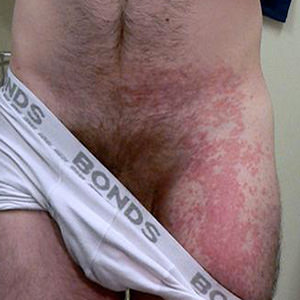
Affected Areas: Nowhere specific
Symptoms:
- May appear after around 3 months and can differ from person to person
- A fever, rash, sore throat, swollen glands, headache, upset stomach or diarrhoea, joint aches and pains and muscle pain (Stage 1)
- No obvious symptoms (Stage 2)
- Weight loss, chronic diarrhoea, night sweats, fever, persistent cough, mouth and skin problems, regular infections and serious illness or disease (Stage 3)
Transmission Sources:
- Unprotected anal, oral or vaginal sex
- Sharing contaminated needles and injecting equipment
- Contaminated blood transfusions and organ/tissue transplants
Treatable: Yes (with antiretroviral drugs to control the virus). Note: HIV cannot be cured, as the virus never leaves the body.
Human Papilloma Virus (HPV) (Viral)
Human Papillomavirus (HPV) is a very common Sexually Transmitted Infection (STI) that is spread through skin-to-skin contact and can affect different parts of the body and can also be referred to as genital warts. There are also different types of HPV, with some types having no visible symptoms or they may only cause warts, with some types that are especially spread through vaginal, oral or anal sex considered to be high-risk that can sometimes cause serious illness including certain cancers if left untreated. High-risk HPV is responsible for 5% of all cancers worldwide, including 90% of anal cancers and 50% of penile cancers. It can take up to 10 years for a high-risk HPV infection to develop into cancer, with men who have sex with men (MSM) having a higher risk of HPV-associated disease. A vaccine is available that is considered to be highly effective at preventing HPV-related illnesses.

Affected Areas: Nose, Mouth, Throat, Anus, Penis, Scrotum, Perineum, Skin
Symptoms:
- May appear up to 1 to 3 months after exposure
- Sometimes there are no symptoms at all and the virus is cleared within 1 to 2 years
- Genital warts can appear, which may be small and difficult to see or can join together to become larger.
Transmission Sources:
- Unprotected anal, oral or vaginal sex
- Close contact with an infected person, including hugging and kissing
Treatable: Yes (may heal naturally, warts can be treated with cryotherapy, creams or laser treatments)
Lymphogranuloma Venereum (LGV) (Bacterial)
This is a rare Sexually Transmitted Infection caused by the aggressive strains of the bacteria that cause Chlamydia and is mainly found in gay and bisexual male populations. LGV can cause severe symptoms, but it can be successfully treated with antibiotics. People with LGV may have fever, chills, weight loss, have sore muscles and joints and may feel generally unwell and if the infection is in the anus, this can create discomfort or paint and result in anal discharge or bleeding. Some people may not have any symptoms at all. If LGV is left untreated, it can result in scarring in the anus, which can cause narrowing of the rectal passageway. Treatment involves 3 weeks of antibiotics and sometimes surgery is required in later stages of the disease.
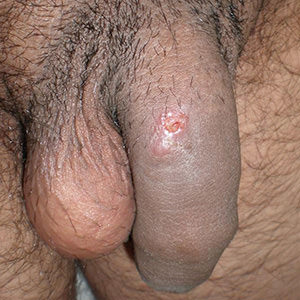
Affected Areas: Anus, Urethra, Penis, Rectum, Mouth, Groin
Symptoms:
- Symptoms appear around 3 to 30 days after infection
- A fever, chills, weight loss, swollen glands, anal discomfort, anal discharge and/or bleeding, joint aches and muscle pain
- Lymph glands may become swollen and fill with pus, resulting in an abscess that may burst open
- A small painless lump of sore can appear at the site of infection, which is usually on the penis, rectum or mouth.
Transmission Sources:
- Unprotected anal, oral or vaginal sex
- Sharing unwashed or uncovered sex toys with someone who has the infection
Treatable: Yes (antibiotics)
Molluscum Contagiosum (Viral)
Molluscum Contagiosum is a viral infection caused by the molluscipoxvirus, which can be transmitted by direct skin-to-skin contact where there are breaks in the skin and it can also be transmitted sexually when it affects the genital area. The virus causes small painless pink or pearly white lumps on the skin. The top of the lump is indented and contains a white core. The infection can clear up on its own without treatment, which may take several months, with lumps often disappearing after about 2 months, with some taking up to 6 to 8 months, however, people who are immune suppressed may have more lesions that take longer to clear up. Cryotherapy (freezing) may sometimes be used for cosmetic reasons.
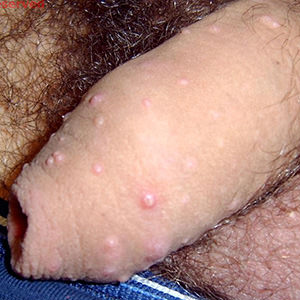
Affected Areas: Genital Area, Skin
Symptoms:
- Symptoms may appear in 2 to 7 weeks, but it can sometimes take longer
- Small painless pink or pearly white lumps on the skin with a white core on the top
Transmission Sources:
- Unprotected anal, oral or vaginal sex
- Close contact with an infected person, including hugging and kissing
Treatable: Yes (may heal naturally)
Non-specific Urethritis (NSU) (Bacterial)
Urethritis refers an infection of the urethra, which is the tube that runs from the bladder to the outside. Urine and semen pass through this tube. Non-specific Urethritis (NSU) most commonly means there is an infection in the urethra. Sometimes the cause of the infection can be found but often is not proven. If left untreated, non-specific urethritis may lead to inflammation of the scrotum and be painful during sex. Antibiotics can treat most urethritis infections.

Affected Areas: Anus, Urethra, Penis, Testicles
Symptoms:
- May appear up to 3 weeks after exposure
- White/cloudy discharge from the penis
- Inflammation of the testicles
- Desire to urinate more frequently
- Painful or burning sensation when urinating
- Flu-like symptoms
Transmission Sources:
- Unprotected anal, oral or vaginal sex
- Sharing contaminated needles and injecting equipment
Treatable: Yes (with antibiotics)
Pubic Lice (Parasitic)
Pubic lice are tiny insects that are brown or grey in colour and shaped like tiny crabs, which is why people sometimes refer to having crabs and not pubic lice. They live on the course hair of the pubic area, body and armpits and may also live in strong hair of the face such as beards and eyelashes. Lice feed on human blood and can live up to four weeks on the human body, but die within 24 hours away from the human body on clothes, bedding or other material. An infestation can lead to minor complications, such as eye inflammation or infections and skin problems, along with the symptoms of scratching. Treatments can be purchased from the chemist or drug store and if you are taking antiretrovirals (ART), ensure you tell your treating health professional, as treatment for public lice may interact with HIV medication.
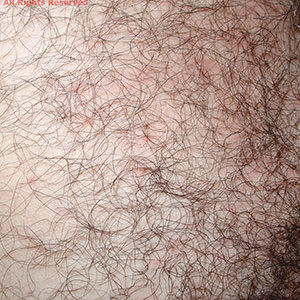
Affected Areas: Genital Area, Pubic Area
Symptoms:
- Symptoms may appear in 5 days to 7 weeks
- Intense itching in the genital area
- Inflammation and irritation caused by scratching
- Black powder in underwear
- Blue spots or small spots of blood on skin in places such as thighs or lower abdomen
Transmission Sources:
- Unprotected anal, oral or vaginal sex
- Close contact with an infected person, including hugging and kissing
Treatable: Yes (with insecticide cream, lotion or shampoo)
Scabies (Parasitic)
Scabies is a skin infestation with a mite called sarcoptes scabiei var hominis. These mites burrow into the skin where they live and reproduce. Eggs laid in the burrows hatch, crawl out onto the skin and make new burrows. Scabies can be treated with special creams purchased from the chemist or drug store or an oral medication for more serious cases.
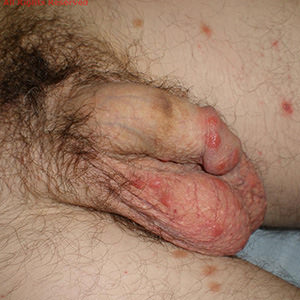
Affected Areas: Penis, Anus, Scrotum, Fingers, Wrists, Arms, Legs
Symptoms:
- May appear in 4 to 6 weeks
- Itchy lines and bumps on the fingers, wrists, arms, legs and belt area
- Severe itch, with scratching at night
- Enflamed bumps on the penis
Transmission Sources:
- Close contact with an infected person, including hugging and kissing
Treatable: Yes (with creams or oral medication)
Syphilis (Bacterial)
Syphilis is curable and is caused by a microscopic parasite, which is highly infectious. At first it causes sores or ulcers on the genitals, but if it’s not treated, the infection can spread through the body and may infect the brain and other organs. It has serious long term effects. If left untreated, syphilis can cause mental illness, blindness, heart disease or even death and syphilis may progress more quickly in people living with HIV.
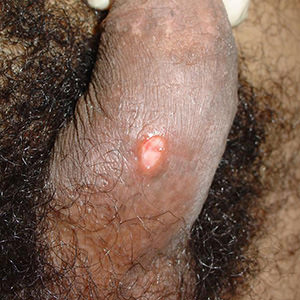
Affected Areas: Anus, Mouth, Penis, Rectum, Scrotum
Symptoms:
- May appear in 21 days (primary stage)
- Sometimes none at all, but can be detected by a blood test
- Painless sores on the penis, mouth or anus
- Rash on the body
- Flu-like symptoms
Transmission Sources:
- Unprotected anal, oral or vaginal sex
- A non-infected person’s genitals touching an infected person’s genitals
- Sharing unwashed or uncovered sex toys with someone who has the infection
- Sharing contaminated needles and injecting equipment
Treatable: Yes (antibiotics)
References and Further Reading:
- Sexually Transmitted Diseases (STDs)
- Sexually Transmitted Infections (STIs)
- SmartSex Resource
- STI Atlas
Featured Photo: © Can Stock Photo / Ruslan117
Article ID: CC072
Version Control: 1.0 – November 12, 2023: Original article published.





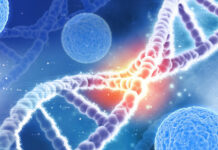
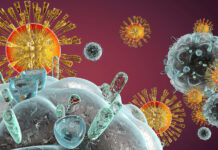

Wow great guide. I had no idea there were so many. Honestly. Just seeing pictures makes me hard. I’m still dealing with that fact but it’s a fact I can’t help. Question for all. As a new bug chaser I always assumed the contraction of the other STIs would be not visible but if and when the time comes and a gifted breeds me with an STI clearly visible. How do I make sure I don’t freak out of stop the top from entering me. Is this something that eventually I will want to see and know.
Himbo you’re pretty much left with “winging it”. Sometimes you’ll stop the action, other times you won’t. I encourage you to follow your gut feel. Although I acknowledge that sometimes our gut feel is complex.
I can’t, and absolutely don’t want to, stop myself from sourcing all STD’s and doing what I can to delay any treatments.
Thank you for such a comprehensive and easily understandable guide. Some of these STI’s I have had principally gono, syph, anal warts, herpes and crabs. (I hate crabs!) My doctor’s assistant keeps harping on the prevalence of chlamydiae so much and in such a non-judgmental way (he knows I bareback and doesn’t try to discourage me) that I feel sometimes he is looking forward to me getting it (so he can treat it presumably?) So perhaps that is on my list of next? And there is still hiv which I thought I had but did not.
I appreciate your kind words about this article Tom. I tried to make it detailed, yet easy to find what you’re looking for. Your doctor’s assistant sounds like an interesting person and I do wonder if he likes to treat any bugs you collect as a result of barebacking. I’m sure he’s on standby if you do contract anything, ready to assist with the treatment.